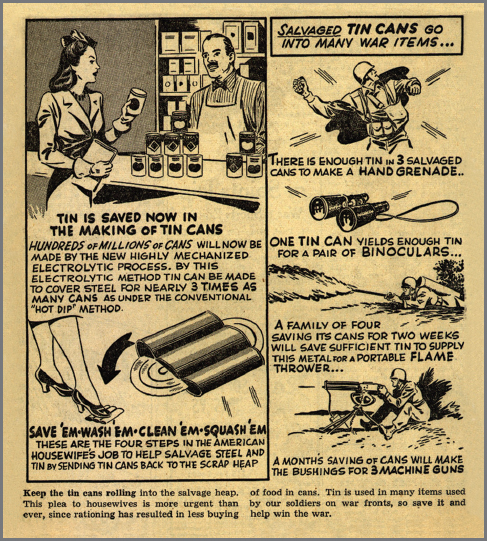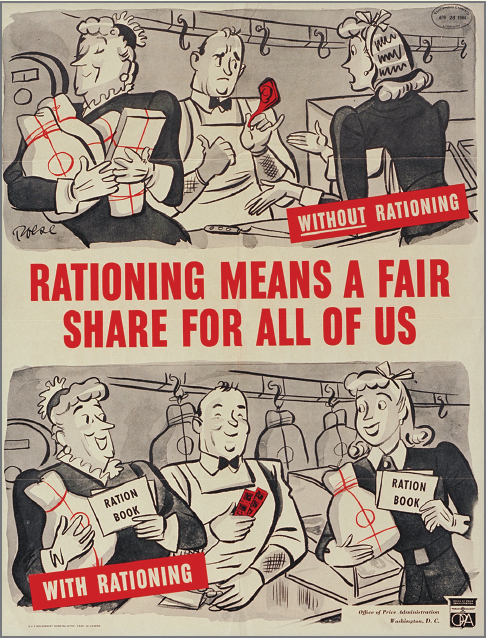Thinking Like a Historian: Mobilizing the Home Front
The U.S. Office of War Information (OWI) promoted everything from food rationing to car-pooling during World War II, and the U.S. Treasury encouraged millions of Americans to buy war bonds. More than 20 million victory gardens were planted by ordinary Americans. By 1944 they were producing more than 40 percent of all vegetables grown in the United States. Through these and other measures, those on the home front were encouraged to see themselves as part of the war effort.
- U.S. government advertisement from the Minneapolis Star Journal, 1943.
 John W. Hartman Center for Sales, Advertising and Marketing History, Duke University.
John W. Hartman Center for Sales, Advertising and Marketing History, Duke University. - Copy from War Advertising Council/U.S. Treasury Department advertisement, 1943.
Farmer: “Well, there’s something we really want now — more than anything else … and I guess everybody does. It’s VICTORY IN THIS WAR! We had started saving for a new milking machine and a deep-well pump that we will be needing in a few years. … We’re still going to have that milking machine and that pump — and a lot of other new improvements after the war. When our son comes home from the fighting front, he’ll help us pick them out. And we’ll have the cash to pay for them. With the money we are saving now in War Bonds. And we are going to hang on to as many War Bonds as possible to take care of us after our boy takes over on the farm. For after ten years, we get four dollars back for every three we have invested.”
- Poster from the U.S. Office of Price Administration, 1943.
 United States Office of Price Administration/Northwestern University Library.
United States Office of Price Administration/Northwestern University Library. - 4-H Club exhibiting victory garden posters, c. 1943.
 Source: “4-H club boys and girls” ID: 0016623, Special Collections Research Center, North Carolina State University Libraries, Raleigh, North Carolina.
Source: “4-H club boys and girls” ID: 0016623, Special Collections Research Center, North Carolina State University Libraries, Raleigh, North Carolina. - Oral histories about life during the war.
Tessie Hickam Wilson, a young woman from Oklahoma.
It was a hard time, but we felt like we were doing our part, and all the people we knew were doing their part. We had rationing. Sugar, coffee, gasoline and meat were some of the items that were hard to come by. We had ration books every so often, and we had to use them sparingly. We bought savings bonds to help in the war effort.
We also had radios and record players, and when we could afford it, we went to the movies. And even though there were hard times, we did what we could in the war effort, and I will always be glad I was part of it.
Virginia J. Bondra, a student and clothing worker from Ohio.
The only newsreel footage we saw was in the theaters when we went to a movie. And we used to bring scrap metal or cans, and we’d get in the movies free. They needed scrap metal and they — the USA needed scrap fat. My mother used to scrap fat, you know, in a can. She’d save it, and we’d bring it to a certain place. Sugar was rationed. Each member of the family would get one pound of sugar a week. And I always had time to bake because we had sugar. …
Different things were rationed. We couldn’t buy nylons because it was needed … for parachutes. So we’d — we’d — my older sisters would paint their legs with a certain makeup that came out in place of nylons. … It was makeup for legs.
They painted a eyebrow pencil line down the back of their leg so it would look like real nylons. And we would write V-mail. I had brother — brothers-in-law in the service. We — we’d write V-mail to them. It was called V-mail. Victory mail. … We couldn’t put their address on because they were moved around a lot and we didn’t want the enemy to know. There were a lot of secrets. They would say “zip your lip was the” — was the word of the days then. “Zip your lip” because we didn’t want the enemy to get information.
Sources: (2) Digital Collections, Duke University Libraries; (4) National Park Service, Rosie the Riveter: Women Working During World War II, and the Library of Congress Veterans History Project.
ANALYZING THE EVIDENCE
Question
VS0AVWuapVEXimj7HBdEjzzyKItelvWZ9AEzyugKodCTRGkE3D1WrB/T3Qn+Sow1dSKaqMHdRmwRunQ6Vy+/tS5wS9fsbm3xl0wGtH5gvOwl88ZaNqxqqPrUwJgOhQMgoIuZAOrlxfR/G05DfjCAVCp81k/mHVYvTJoaH3FIhK6QfC8I+DKqF1LLBiOcn6TUNB/8Mbn45OkoUYnC1aA0d4AqtCcU4iWU5vQWtu3zq3Y2wKY0Lr9FmVymLRL39I/tsuNtDYVgZjTS9JCkK6+F5KPn3bQ=Question
SN0Bs1PQJDTa3mNx1zea0zjUalBXmmavj9mbPWYgDG/DGe0wDaO4YpWLGDVeWKFOUGmM1v031/wljIdxXAbo7+rTPgFCcLLznbpOLd4QFrlaV7uda7SekB63CURfbeEGR0ksCtz3H+SAtfT7vW9m7NFDjXwKEnozUPtFU9b7TdwQEt94TMZ2KVMv0r8DTEWQyS8r+ijrFSgcci/aVX0YZOrGZiCtdhVIFz4c5kbadPO0NsF/mQn2y88WJ5ULM1x/fqgibwZKvcVcq0U7Question
GTs4cMTuIKKxn3vjCbAPIUF063j7Lf3Hr7MJAcQnSObtBepVTbpoguUdvOrUPmhG5mQDvO2VF5J+J7fR17tw9LvcvBEFZyqnkHtZXwj3e8FOnrgLxmrebuUQ2UGN0b/9naRBToE6r84MBST0sJvoH3rkzlKow/x++ySJRNlvDwjBrVkwV3NbJBpDMLxjhz6pBDpkQAHzrjlHXpdxaa3U8TV2zbV3XTPTgfPOKH66DObYnQsj6tyZbXYDXH1V7QMRMLaDnT9gCp1rhtYc3ra39zoBNlouWWP4
PUTTING IT ALL TOGETHER